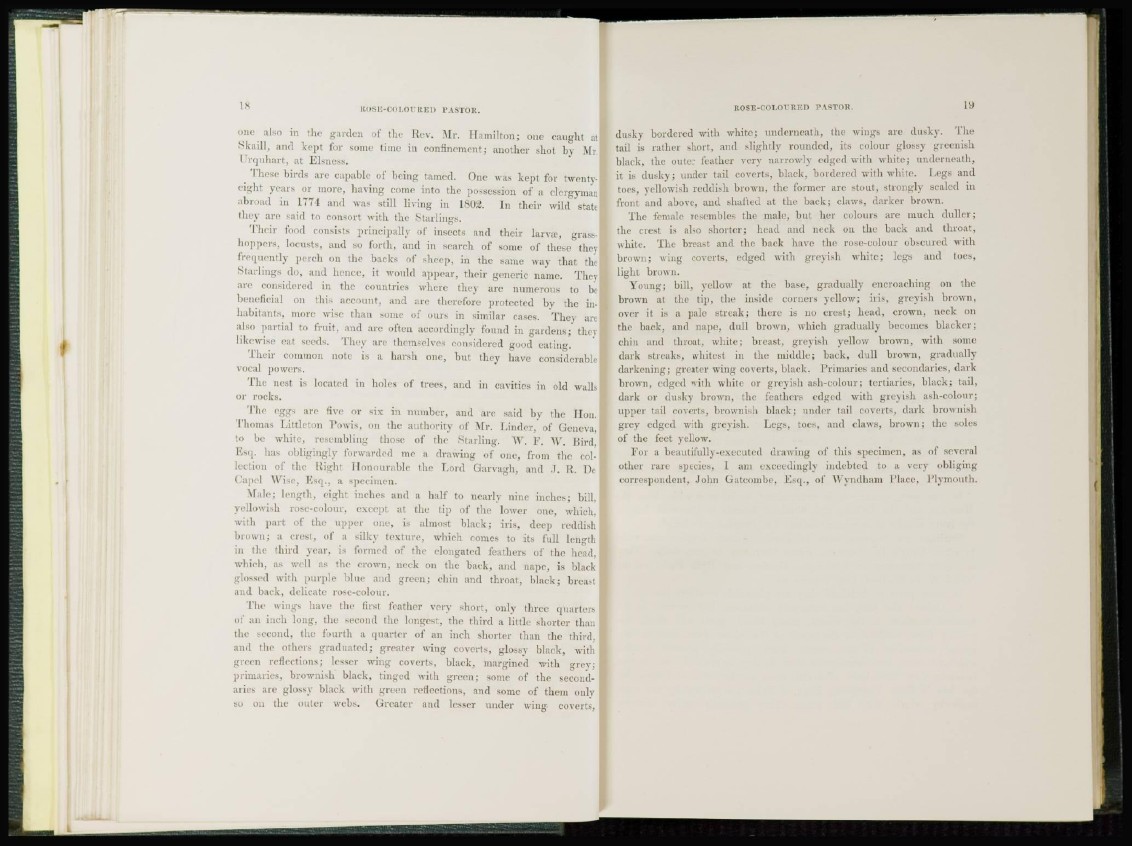
I s ROSE-COLOURED PASTOR.
one also in the garden of the Rev. Mr. Hamilton; o n e caught at
Skaill, and kept for some time in confinement; another shot by Mr.
CJrquhart, at Elsness.
These birds arc capable of being tamed. One was kept for twentyeight
years or more, having come into the possession of a clergyman
abroad in 1774 and was still living in 1802. In their wild stale
t h e y are said to consort with the Starlings.
Their food consists principally of insects and their larva1 , grasshoppers,
locusts, and so forth, and in search of some of these they
frequently perch on the backs of sheep, in the same way that the
S t a r l i n g s do, and hence, it would appear, their generic name. They I
are considered in the countries where they arc numerous to bcbeneficial
on this account, and are therefore protected bv the inh
a b i t a n t s , more wise than some of ours in similar cases. They are £
also partial to fruit, and are often accordingly found in g a r d e n s ; fhev
likewise cat seeds. They are themselves considered good eating.
Their common note is a harsh one, but they have considerable
vocal powers.
The nest is located in holes of trees, and in cavities in old walls
oi" rocks.
The eggs arc five or six in number, and are said bv the Hon.
Thomas Littleton Powis, on the authority of Mr. lander, of Geneva,
to be white, resembling those of the Starling. W. F. W. bird,
Esq. has obligingly forwarded me a drawing of one, from the col-1
lection of the Right Honourable the Lord Garvagh, and J. R. Do
Capel Wise, Esq., a specimen.
Male; length, eight inches and a half to nearly nine inches; bill,
yellowish rose-colour, except at the tip of the lower one, which,
with part of the upper one, is almost black; iris, deep reddish
brown; a crest, of a silky t e x t u r e , which comes to its full length
in the third vear. is formed of the elongated feathers of the h e a d ,!
which, as well as the crown, neck on the back, and nape, is black
iilossed with purple blue and green; chin and throat, black; b r e a s t]
a n d back, delicate rose-colour.
The wings have the lirsl feather very short, only three quarters
oi' an inch long, the second the longest, the t h i r d a little shorter than
t h e second, the fourth a quarter of an inch shorter than the third,
a n d the others graduated; greater wing coverts, glossy black, with I
green reflections; lesser wing coverts, black, margined with grey; I
primaries, brownish black, tinged with green; some of the second- ^
aries arc flossy black with green reHections, and some of them only
so on the outer webs. Greater and lesser under wing- coverts, I
ROSE-COLOT/RED 1' VSTOR. 19
dusky bordered with white; underneath, the wings are dusky. Che
tail is rather short, and slightly rounded, its colour glossy greenish
black, the outer feather very narrowly edged with white; underneath,
it is dusky; under tail coverts, black, bordered with white. Legs and
toes, yellowish reddish brown, the former are s t o u t , strongly scaled in
front and above, and shafted at the back; claws, darker brown.
The female resembles the male, but her colours are much duller;
the crest is also shorter; head and neck on the back and throat,
white. The breast and the back have the rose-colour obscured with
brown: wing coverts, edged with greyish white; legs and toes,
light brown.
Young; bill, yellow at the base, gradually encroaching on the
brown at the tip, the inside corners yellow; iris, greyish brown,
over it is a pale streak; there is no crest; head, crown, neck on
the back, and n a p e , dull brown, which gradually becomes blacker;
chin and throat, white; breast, greyish yellow brown, with some
dark streaks, whitest in the middle; back, dull brown, gradually
darkening; greater wing coverts, black. Primaries and secondaries, dark
brown, edged with white or greyish ash-colour; tertiaries, black; tail,
dark or dusky brown, the feathers edged with greyish ash-colour;
upper tail coverts, brownish black; under tail coverts, dark brownish
grey edged with greyish. Legs, toes, and claws, brown; the soles
of the feet yellow.
For a beautifully-executed drawing of this specimen, as of several
other rare species, I am exceedingly indebted to a very obliging
correspondent, John Gatcombe, Esq., of Wvndham Place, Plymouth.